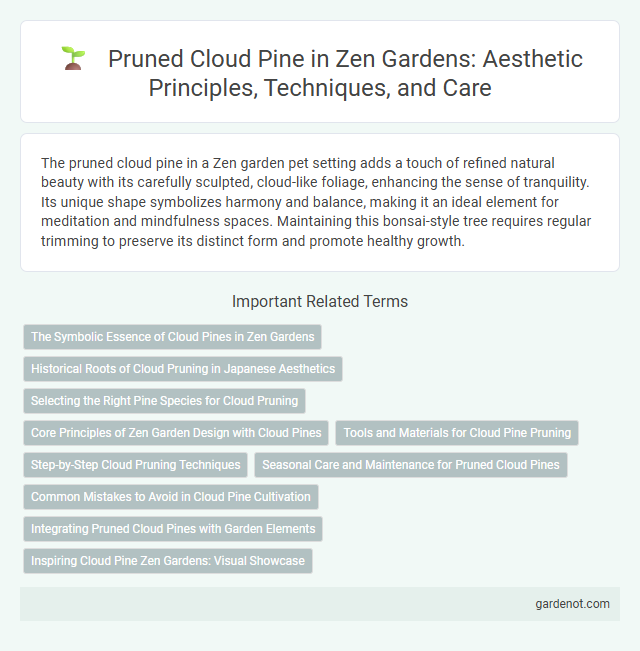The pruned cloud pine in a Zen garden pet setting adds a touch of refined natural beauty with its carefully sculpted, cloud-like foliage, enhancing the sense of tranquility. Its unique shape symbolizes harmony and balance, making it an ideal element for meditation and mindfulness spaces. Maintaining this bonsai-style tree requires regular trimming to preserve its distinct form and promote healthy growth.
The Symbolic Essence of Cloud Pines in Zen Gardens
Pruned cloud pines in Zen gardens embody resilience and serenity, symbolizing the harmony between nature and human intervention. Their carefully sculpted forms reflect the Zen principles of balance and mindfulness, enhancing the garden's contemplative atmosphere. These trees serve as living metaphors for patience and the beauty of imperfection, central to Zen aesthetics.
Historical Roots of Cloud Pruning in Japanese Aesthetics
Pruned cloud pine, known as "kumo-gata" in Japanese horticulture, reflects centuries-old techniques integral to traditional Japanese garden design shaped during the Edo period. This style of cloud pruning originated from Zen Buddhist principles emphasizing natural landscapes and minimalist beauty, aiming to evoke clouds or mist through carefully sculpted pine foliage. Its historical roots lie in the fusion of aesthetic discipline and spiritual symbolism, where the pine represents longevity and resilience within the serene context of Zen gardens.
Selecting the Right Pine Species for Cloud Pruning
Choosing the right pine species is crucial for achieving the iconic shapes in cloud pruning, with Japanese black pine (Pinus thunbergii) and Japanese white pine (Pinus parviflora) being the most popular due to their dense, flexible branches and tolerance to pruning. These species respond well to careful shaping and maintenance, enhancing the sculptural effect typical of Zen gardens. Proper species selection ensures longevity and visual harmony in cloud-pruned pines, supporting the garden's meditative ambiance.
Core Principles of Zen Garden Design with Cloud Pines
Pruned cloud pines exemplify the core principles of Zen garden design by embodying simplicity, balance, and natural elegance through meticulous shaping that mimics clouds in the sky. Their layered, sculpted forms create a sense of tranquility and harmony, reflecting the Zen emphasis on mindfulness and the beauty of imperfection. These trees serve as focal points, guiding the viewer's attention while maintaining a seamless integration with rocks, sand, and water elements essential to Zen aesthetics.
Tools and Materials for Cloud Pine Pruning
Essential tools for pruning a cloud pine in a Zen garden include sharp bypass pruning shears, long-handled pole pruners, and specialized concave cutters to promote precise cuts and healthy regrowth. High-quality materials such as sterilizing solution for tools, sturdy gloves, and soft cloths for cleaning branches prevent disease and maintain the tree's aesthetic form. Using natural twine or raffia helps gently secure branches during shaping, ensuring the iconic layered appearance without damaging the delicate foliage.
Step-by-Step Cloud Pruning Techniques
Pruned cloud pine requires precise step-by-step cloud pruning techniques to maintain its iconic layered appearance, starting with identifying the main branches for structural balance. Carefully prune new growth back to a set of buds, shaping each cloud to create soft, rounded forms that mimic natural cloud clusters. Regular maintenance pruning every few weeks ensures the silhouette remains clear and emphasizes the tree's sculptural elegance within a Zen garden.
Seasonal Care and Maintenance for Pruned Cloud Pines
Pruned cloud pines require careful seasonal care to maintain their distinct layered appearance and overall health. In spring, apply balanced fertilizer and ensure adequate watering to support new growth, while summer demands regular pruning to preserve shape and prevent overcrowding. During winter, protect roots with mulch and reduce water frequency to prevent stress from cold temperatures.
Common Mistakes to Avoid in Cloud Pine Cultivation
Improper pruning of cloud pine often leads to uneven growth and loss of its characteristic cloud-like structure. Overwatering can cause root rot, while insufficient sunlight hinders the tree's development and vitality. Avoid using improper tools or techniques that damage branches, as this stresses the tree and reduces its aesthetic appeal in Zen gardens.
Integrating Pruned Cloud Pines with Garden Elements
Pruned cloud pines serve as a striking focal point in Zen gardens, their carefully sculpted branches enhancing the overall harmony of the landscape. Integrating these trees with elements like raked gravel, stone lanterns, and water basins creates a balanced interplay of natural and architectural features. Strategic placement of cloud pines emphasizes spatial depth, guiding the viewer's eye through layers of texture and calm within the garden.
Inspiring Cloud Pine Zen Gardens: Visual Showcase
Pruned cloud pine, with its meticulously sculpted foliage and layered branches, creates a captivating focal point in Zen gardens, symbolizing harmony and balance. Its unique cloud-like shapes evoke a sense of tranquility and artistic precision, inspiring serene garden designs that emphasize simplicity and natural beauty. Showcasing these trees in Zen garden layouts highlights the blend of nature and careful cultivation essential to traditional Japanese landscaping.
Pruned cloud pine Infographic

 gardenot.com
gardenot.com